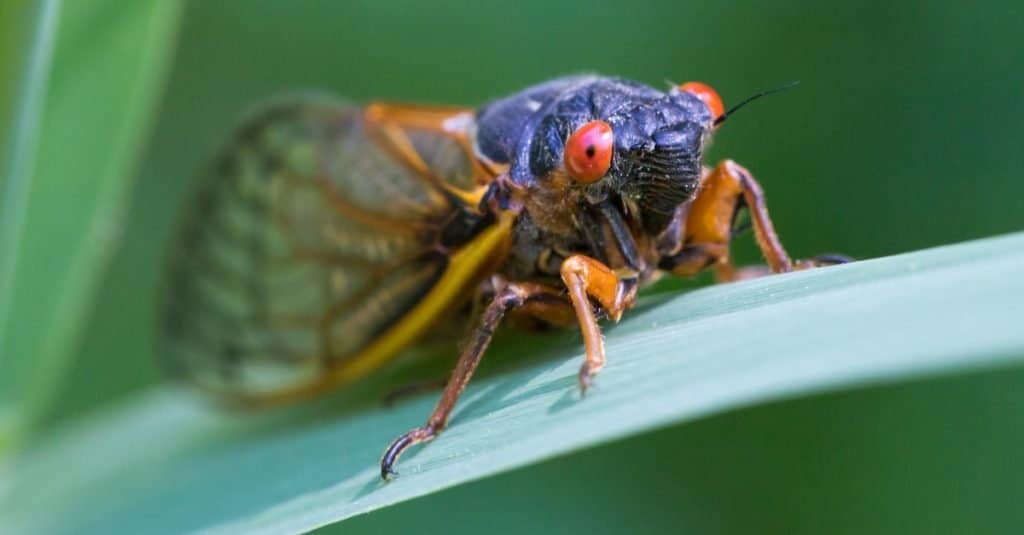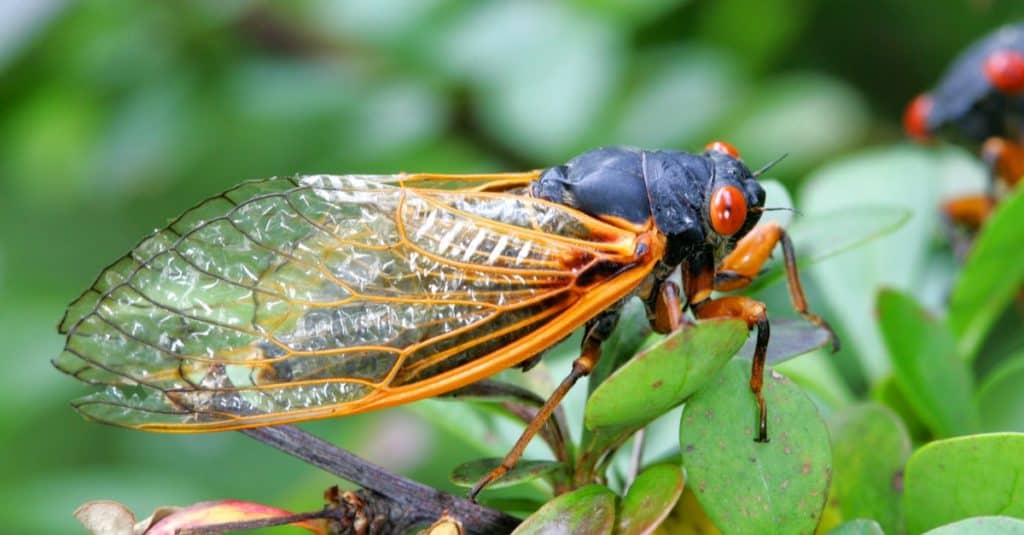At first glance, you might assume that these two insects look exactly like each other. After all, both the cicada and the horsefly are big black bugs that are known for being loud. However, when you take a closer look, you realize that couldn’t be further from the truth. Although they may have some similarities, these two bugs have very distinct differences. Are you curious to learn about these two bugs in our breakdown on the cicada vs. the horsefly? In this article, we’ll discuss the many differences and similarities between these two insects.
Comparing a Cicada and a Horsefly
| Cicada | Horsefly | |
|---|---|---|
| Scientific Name | Cicadoidea | Tabanidae |
| Color Variations | Black, green, gold, and brown | Black, brown, and orange |
| Size | 1 – 1 1/2 inches long | 0.2 – 1 1/4 inches |
| Lifespan | Depending on the species anywhere from 2-5 years or 13-17 years | 30 to 60 days |
| Descriptors | A loud buzzing sound, green wings, neon colored | Biting, loud, black body |
The 4 Key Differences Between a Cicada and a Horsefly

Cicadas can live anywhere from 2-5 years or 13-17 years depending on the species.
©Elliotte Rusty Harold/Shutterstock.com
There are several main differences between a cicada and a horsefly. Some of these differences include their size, behavior, appearance, diet, and lifespan. Those of us who have experienced cicada season know that they’re not always around. They only seem to pop up every couple of years depending on which brood they are a part of. However, you always know when they’re around because of how loud they are! On the other hand, horseflies are active every year — usually between May and September. They’re a notorious summer insect whose bite is known to be painful.
Let’s explore all of the main differences between these two insects below. We’ll uncover what makes them both unique and fascinating facts you may not be aware of when it comes to these two.
Cicada vs. Horsefly: Behavior

Female horseflies are notoriously aggressive and rely on blood to feed themselves.
©iStock.com/dabjola
Let’s start off by comparing the behavior of these two insects. For starters, the cicada only shows up every few years. They spend much of their lives underground. Cicadas spend a lot of time developing underground before they are able to come out and begin singing their obnoxiously loud song. Every two to five years, there are approximately 3,400 cicada species that emerge. However, there are some species that spend time underground for 13-17 years. A great example is the Magicicicada species, which emerges in the millions after spending over a decade underground. Once the cicadas come out from hiding, they make their presence known. They create such a loud buzzing sound that some have described it as sounding like a jet engine. Then a few weeks later, they disappear.
Horseflies, on the other hand, are a known summertime threat. These flies love damp and hot weather. This is why they’re typically around from May up until September. These flies belong to a family of flies known as the Tabanids. Female horseflies are notoriously aggressive and they rely on blood to feed themselves. The protein from the blood allows them to fertilize their eggs. This means that these flies will chase down their meals. Their bites are painful and many people recognize them immediately because of their loud buzzing. It’s probably because of this loud buzzing that they are often confused with cicadas.
Cicada vs. Horsefly: Size and Appearance

Cicadas have rounded, stout bodies and four wings, with the first pair of wings being longer than their bodies.
©David ODell/Shutterstock.com
When comes to their size and overall appearance, the cicada and the horsefly are actually not as similar as you might think. Let’s begin by breaking down the size and appearance of the cicada. The cicada is a relatively small insect, coming in at 1 – 1 1/2 inches long. They have rounded stout bodies that are usually green or brown in color. Their bodies will also usually be covered with black markings. Cicadas also have four wings that are clear and their first pair of wings are longer than their entire bodies. These large wings then fold over their backs. Their front antennas are also quite short.
Horseflies, in comparison, are typically 3/4 to 1-1/4 inches long. The adult horsefly is typically brown or black in color and has a hairy appearance. Unlike the cicada, they only have one pair of wings. Their wings also have dark markings on them. One of their more distinguishing features is their large eyes which are often green or purple in color with horizontal stripes. These insects also have six legs and short antennae. As you can see, while these two insects may have one or two similarities, overall they are quite different in appearance.
Cicada vs. Horsefly: Diet

Horseflies, unlike cicadas, are a threat to both animals and humans as they are known to spread disease.
©iStock.com/MegaV0lt
The diets of cicadas and horseflies are also incredibly different. An adult cicada actually has piercing mouthparts, like those of a mosquito. However, cicadas, unlike horseflies and mosquitos, are not a threat to humans or animals at all. Instead, adult cicadas use these piercing mouthpieces in order to suck fluids from plants. They enjoy eating fluids from a variety of trees including willows, maples, and oaks. However, when those aren’t around they’ll just eat whatever plants are available to them.
Horseflies, unlike cicadas, are actually a threat to both animals and humans. As we mentioned above, the horsefly relies on the proteins from blood in order to survive and reproduce. Female horseflies drink blood from both humans and animals. They have even been known to spread diseases. Male horseflies, on the other hand, actually only eat nectar and pollen. They don’t drink blood at all. Interestingly enough, although female horseflies rely on blood, they too will eat nectar and pollen as well.
Cicada vs. Horsefly: Lifespan

Cicadas spend the longest part of their lives underground.
©Chris Alcock/Shutterstock.com
The cicada’s lifespan is surprisingly long. However, this all depends on the exact species of cicada. There are some cicadas that only live for two to five years. Still, there are others that have a lifespan of about 13-17 years. The fascinating thing about cicadas is that they spend a lot of their lives as nymphs living underground. Their time spent underground is actually the longest part of their lives. Once the cicadas make it out above ground, they will generally only live a few weeks. The average adult horsefly has a lifespan of about 30 to 60 days. They also have an interesting lifespan as the larval stage can last as long as a year.
The photo featured at the top of this post is ©
Thank you for reading! Have some feedback for us? Contact the AZ Animals editorial team.






